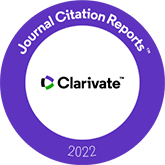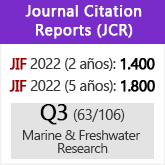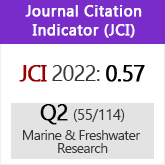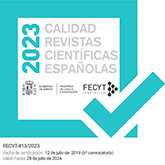Ciclo de vida y dinámica poblacional de la enigmática tanaide Chondrochelia dubia (Tanaidacea: Leptocheliidae) en un lecho de algas tropicales
DOI:
https://doi.org/10.3989/scimar.05322.059Palabras clave:
epifauna, Peracarida, derrame de petróleo brasileño, arrecife, macroalgae, leptoquelidosResumen
El presente estudio describió la dinámica poblacional y los parámetros del ciclo de vida del enigmático tanaidáceo Chondrochelia dubia recolectado en la playa de Paiva, costa tropical de Brasil. La región se vio afectada por un gran derrame de petróleo inesperado de agosto a octubre de 2019. Se tomaron muestras mensualmente entre julio de 2019 y julio de 2020 en lechos de algas rojas Jania capillacea. La abundancia de individuos se correlacionó negativamente con la precipitación mensual, con mayor abundancia en los meses más secos. Hubo una inesperada caída significativa de la abundancia en septiembre, posiblemente causada por el contacto con el petróleo crudo, sin embargo, la población se recuperó por completo en dos meses. Los parámetros de la ecuación de crecimiento de von Bertallanfy, calculados por primera vez para la especie, fueron: Linf=5.26 mm; k=3.36 año–1; t0=0,0. En comparación con otros estudios, los ejemplares son muy pequeños (2.04 ± 0.95 mm de longitud), las hembras alcanzan la madurez sexual muy temprano (L50=2.3 mm), y la mortalidad natural es relativamente alta (Z=M=5.77 año–1), lo que indica una estrategia de vida oportunista. Este estudio refuerza el potencial de bioindicación de C. dubia y el uso de métodos bootstrap basados en la longitud para estimar parámetros de población clave en pequeños invertebrados marinos.
Descargas
Citas
Abundez J., Moreno G., Simoes N., et al. 2021. Marine amphipods (Parhyale hawaiensis) as an alternative feed for the lined seahorse (Hippocampus erectus, Perri 1810): Nutritional value and feeding trial. PeerJ. 9: 1-28. https://doi.org/10.7717/peerj.12288 PMid:34721977 PMCid:PMC8532987
Almeida M. 1994. Kalliapseudes schubartii Mañé-Garzón, 1949 (Tanaidecea-Crustacea): Dinâmica populacional e interações com a macrofauna bêntica no Saco do Limoeiro, Ilha do Mel (Paraná, Brasil). MSc thesis, Universidade Federal do Paraná, 75pp.
Araújo-Silva C., Sarmento V., Santos P. 2022. Climate change scenarios of increased CO2 and temperature affect a coral reef peracarid (Crustacea) community. Mar. Environ. Res. 173: 1-11. https://doi.org/10.1016/j.marenvres.2021.105518 PMid:34763317
Bamber R. 2010. In the footsteps of Henrik Nikolaj Krøyer: The rediscovery and redescription of Leptochelia savignyi (Krøyer, 1842) sensu stricto (Crustacea: Tanaidacea: Leptocheliidae). Proc. Biol. Soc. Wash. 123: 289-311. https://doi.org/10.2988/10-14.1 PMid:33643520
Berrigan D., Charnov E. 1994. Reaction Norms for Age and Size at Maturity in Response to Temperature: A Puzzle for Life Historians. Oikos. 70: 474-478. https://doi.org/10.2307/3545787
Blazewicz-Paszkowycz M., Bamber R., Anderson G. 2012. Diversity of Tanaidacea (Crustacea: Peracarida) in the world's oceans - how far have we come? PLoS ONE. 7: 1-11. https://doi.org/10.1371/journal.pone.0033068 PMid:22496741 PMCid:PMC3319556
Boyer T., Baranova O., Coleman C., et al. 2018. NOAA Atlas NESDIS 87, Silver Spring, MD, 207 pp.
Buckle Ramirez L.F. 1965. Untersuchungen über die Biologie von Heterotanais oerstedi Kröyer (Crustacea, Tanaidacea). Zeitschrift Für Morphologie Und Ökologie Der Tiere. 55: 714-482. https://doi.org/10.1007/BF00406235
Cardoso R., Defeo O. 2004. Biogeographic patterns in life history traits of the Pan-American sandy beach isopod Excirolana braziliensis. Estuar. Coast. Shelf Sci. 61: 559-568. https://doi.org/10.1016/j.ecss.2004.06.021
Carvalho N., Grande H., Rosa Filho J., Jacobucci G. 2018. The structure of gammarid amphipod (Crustacea, Peracarida) assemblages associated with Sargassum (Phaeophyta, Fucales) and their link with the structural complexity of algae. Hydrobiologia. 820: 245-254. https://doi.org/10.1007/s10750-018-3661-5
Craveiro N., Alves R., Menezes J., et al. 2021. Immediate effects of the 2019 oil spill on the macrobenthic fauna associated with macroalgae on the tropical coast of Brazil. Mar. Pollut. Bull. 165: 1-8. https://doi.org/10.1016/j.marpolbul.2021.112107 PMid:33550001
de Souza F., Gilbert E., de Camargo M., Pieper W. 2013. The spatial distribution of the subtidal benthic macrofauna and its relationship with environmental factors using geostatistical tools: A case study in Trapandé Bay, southern Brazil. Zoologia 30: 55-65. https://doi.org/10.1590/S1984-46702013000100007
Domingues E.C., Schettini C.A.F., Truccolo E.C., Oliveira Filho J.C. de. 2017. Hidrografia e correntes da Plataforma Continental de Pernambuco. Rev. Bras. de Recur. Hidr. 22: 1-17. https://doi.org/10.1590/2318-0331.0217170027
Ewers-Saucedo C. 2019. Evaluating reasons for biased sex ratios in Crustacea. Invertebr. Reprod. Dev. 63: 222-230. https://doi.org/10.1080/07924259.2019.1588792
Fonseca D., D'Incao F. 2003. Growth and reproductive parameters of Kalliapseudes schubartii in the estuarine region of the Lagoa dos Patos (southern Brazil). J. Mar. Biolog. Assoc. U.K. 83: 931-935. https://doi.org/10.1017/S0025315403008087h
Fontoura N., Braun A., Milani P. 2009. Estimating size at first maturity (L50) from Gonadossomatic Index (GSI) data. Neotrop. Ichthyol. 7: 217-222. https://doi.org/10.1590/S1679-62252009000200013
Gardiner L. 1975. The Systematics, Postmarsupial Development, and Ecology of the Deep-Sea Family Neotanaidae (Crustacea: Tanaidacea) (Vol. 170). Smithsonian Institution Press, City of Washington, 274 pp . https://doi.org/10.5479/si.00810282.170
Guevara M., Lodeiros C., Donato M., et al. 2005. Nutritional quality of Metamysidopsis insularis Brattegard (Crustacea: Mysidacea). Aquac. Nutr. 11: 315-319. https://doi.org/10.1111/j.1365-2095.2005.00361.x
Guțu M. 2016. Systematic Novelties of the Enigmatic Universe of the Leptocheliids: Crustacea: Tanaidacea. ePublishers, Bucharest, 205 pp.
Hacker S., Steneck R. 1990. Habitat Architecture and the Abundance and Body-Size-Dependent Habitat Selection of a Phytal Amphipod. Ecology. 71: 2269-2285. https://doi.org/10.2307/1938638
Highsmith R. 1983. Sex Reversal and Fighting Behavior: Coevolved Phenomena in a Tanaid Crustacean. Ecology. 64: 719-726. https://doi.org/10.2307/1937194
Holanda T., Gonçalves R., Lino A., et al. 2020. Morphodynamic classification, variations and coastal processes of Paiva Beach, PE, Brazil. Rev. Bras. de Geomorfol. 21: 235-251. https://doi.org/10.20502/rbg.v21i2.1796
Holdich D., Jones J. 1983. Tanaids (Synopses of the British Fauna) (Vol. 27). Cambridge University Press, Cambridge, 112 pp.
Horta P., Amancio E. Coimbra C., Oliveira E. 2001. Considerações sobre a distribuição e origem da flora de macroalgas marinhas brasileiras. Hoehnea. 28: 243-265.
Jarquín-González J., Carrera-Parra L. 2022. Chondrochelia Guţu, 2016 (Crustacea, Peracarida, Tanaidacea, Leptocheliidae) from North America: new species, redescription and distribution using morphological and molecular data. PeerJ. 10: 1-47. https://doi.org/10.7717/peerj.12773 PMid:35116196 PMCid:PMC8785663
Johnson S., Attramadal Y. 1982. Reproductive Behaviour and Larval Development of Tanais cavolinii (Crustacea: Tanaidacea). Mar. Biol. 71: 11-16. https://doi.org/10.1007/BF00396987
Kakui K., Fleming J., Mori M., et al. 2021. Comprehensive Transcriptome Sequencing of Tanaidacea with Proteomic Evidences for Their Silk. Genome Biol. Evol. 13: 1-11. https://doi.org/10.1093/gbe/evab281 PMid:34904645 PMCid:PMC8715525
Keesing J., Gartner A., Westera M., et al. 2018. Impacts and Environmental Risks of Oil Spills on Marine Invertebrates, Algae and Seagrass: A Global Review from an Australian Perspective. In: Hawkins S., Evans A., et al. (eds), Oceanography and Marine Biology. CRC Press, pp. 2-61. https://doi.org/10.1201/9780429454455-5
Krasnow L., Taghon, G. 1997. Rate of tube building and sediment particle size selection during tube construction by the tanaid crustacean, Leptochelia dubia. Estuaries. 20: 534-546. https://doi.org/10.2307/1352612
Krøyer H. 1842. Nye Arter af Slaegten Tanais. Naturhistorisk Tidsskrift Ser. I. 4: 167-188.
Laborel J. 1970. Les peuplements de madréporaires des côtes tropicales du Brésil. Annales de l'Universit'e d'Abidjan (Ecologie), Abidjan, 265 pp.
Leite F., Turra A., Souza, E. 2003. Population biology and distribution of the tanaid Kalliapseudes schubarti Mañé-Garzon, 1949, in an intertidal flat in southeastern Brazil. Braz. J. Biol. 63: 469-479. https://doi.org/10.1590/S1519-69842003000300013 PMid:14758706
Longo P., Mansur K., Leite F., Passos F. 2019. The highly diverse gastropod assemblages associated with Sargassum spp. (Phaeophyceae: Fucales) habitats. J. Mar. Biolog. Assoc. U.K. 99: 1295-1307. https://doi.org/10.1017/S0025315419000304
Martínez-Laiz G., Ros M., Navarro-Barranco C., Guerra-García J. 2018. Habitat selection of intertidal caprellid amphipods in a changing scenario. Behav. Process. 153: 16-24. https://doi.org/10.1016/j.beproc.2018.05.005 PMid:29747045
Masunari S. 1983. Postmarsupial development and population dynamics of Leptochelia Sa Vignyi (Kroyer, 1842) (Tanaidacea). Crustaceana. 44: 151-162. https://doi.org/10.1163/156854083X00776
Mathews C., & Samuel, M. 1990. Using the growth performance index Φ' to choose species aquaculture: an example from Kuwait. Aquabyte 3: 2-4.
Mendoza J. 1982. Some Aspects of the Autecology of Leptochelia dubia (Krøyer, 1842) (Tanaidacea). Crustaceana. 43: 225-240. https://doi.org/10.1163/156854082X00164
Mildenberger T., Taylor M., Wolff M. 2017. TropFishR: an R package for fisheries analysis with length-frequency data. Methods Ecol. Evol. 8: 1520-1527 https://doi.org/10.1111/2041-210X.12791
Modlin R., Harris P. 1989. Observations on the natural history and experiments on the reproductive strategy of Hargeria rapax (Tanaidacea). J. Crustac. Biol. 9: 678-586. https://doi.org/10.1163/193724089X00593
Pandian T. 2016. Reproduction and Development in Crustacea. CRC Press, India, 316 pp. https://doi.org/10.1201/b20080
Pauly D., Munro J. 1984. Once more on the comparison of growth in fish and invertebrates. Fishbyte. 2: 1-21.
Pennafirme S., Soares-Gomes A. 2009. Population biology and reproduction of Kalliapseudes schubartii Mañé-Garzón, 1949 (Peracarida, Tanaidacea) in a tropical coastal Lagoon, Itaipu, Southeastern Brazil. Crustaceana 82: 1509-1526. https://doi.org/10.1163/001121609X12487811051589
Pennafirme S., Soares-Gomes A. 2017. Population dynamics and secondary production of a key benthic tanaidacean,
Monokalliapseudes schubarti (Mañé-Garzón, 1949) (Tanaidacea, Kalliapseudidae), from a tropical coastal lagoon in southeastern Brazil. Crustaceana. 90: 1483-1499. https://doi.org/10.1163/15685403-00003704
R Core Team. 2022. R: A language and environment for statistical computing.
Rumbold C., Obenat S., Spivak E. 2015. Comparison of life history traits of Tanais dulongii (Tanaidacea: Tanaididae) in natural and artificial marine environments of the south-western Atlantic. Helgol. Mar. Res. 69: 231-242. https://doi.org/10.1007/s10152-015-0432-9
Schwamborn R., Mildenberger T., Taylor, M. 2019. Assessing sources of uncertainty in length-based estimates of body growth in populations of fishes and macroinvertebrates with bootstrapped ELEFAN. Ecol. Modell. 393: 37-51. https://doi.org/10.1016/j.ecolmodel.2018.12.001
Soares M., Teixeira C., Bezerra L., et al. 2020. Oil spill in South Atlantic (Brazil): Environmental and governmental disaster. Marine Policy. 115: 1-8. https://doi.org/10.1016/j.marpol.2020.103879
Sparre P., Venema S. 1998. Introduction to tropical fish stock assessment - Part I: Manual. FAO, Rome, 423 pp.
Stoner A. 1986. Cohabitation on Algal Habitat Islands by Two Hermaphroditic Tanaidacea (Crustacea: Peracarida). J. Crustac. Biol. 6: 719-728. https://doi.org/10.1163/193724086X00523
Sudo H. 2003. Effect of temperature on growth, sexual maturity and reproduction of Acanthomysis robusta (Crustacea: Mysidacea) reared in the laboratory. Mar. Biol. 143: 1095-1107. https://doi.org/10.1007/s00227-003-1160-2
Tano S., Eggertsen M., Wikström S., et al. 2016. Tropical seaweed beds are important habitats for mobile invertebrate epifauna. Estuar. Coast. Shelf Sci. 183: 1-12. https://doi.org/10.1016/j.ecss.2016.10.010
Taylor C. 1958. Cod Growth and Temperature. ICES J. Mar. Sci. 23: 366-370. https://doi.org/10.1093/icesjms/23.3.366
Toniollo V., Masunari S. 2007. Postmarsupial development of Sinelobus stanfordi (Richardson, 1901) (Tanaidacea: Tanaidae). Nauplius. 15: 15-41.
Torrejon-Magallanes J. 2020. sizeMat: Estimate Size at Sexual Maturity (R package version 1.1.2).
Tuya F., Pérez J., Medina L., Luque A. 2001. Seasonal variations of the macrofauna from three seagrass meadows of Cymodocea nodosa off Gran Canaria (Central-eastern Atlantic Ocean). Cienc. Mar. 27: 223-234. https://doi.org/10.7773/cm.v27i2.462
Zamora-Sarabia F., Arreguín-Sánchez F., de Anda-Montañez, J.A., Jacob-Cervantes M. 2022. Effect of sea surface temperature on the growth performance of the thread herring Opisthonema libertate (Günther, 1868) in the southern Gulf of California. Lat. Am. J. Aquat. Res. 50: 31-38. https://doi.org/10.3856/vol50-issue1-fulltext-2746
Publicado
Cómo citar
Número
Sección
Licencia
Derechos de autor 2023 Consejo Superior de Investigaciones Científicas (CSIC)

Esta obra está bajo una licencia internacional Creative Commons Atribución 4.0.
© CSIC. Los originales publicados en las ediciones impresa y electrónica de esta Revista son propiedad del Consejo Superior de Investigaciones Científicas, siendo necesario citar la procedencia en cualquier reproducción parcial o total.Salvo indicación contraria, todos los contenidos de la edición electrónica se distribuyen bajo una licencia de uso y distribución “Creative Commons Reconocimiento 4.0 Internacional ” (CC BY 4.0). Puede consultar desde aquí la versión informativa y el texto legal de la licencia. Esta circunstancia ha de hacerse constar expresamente de esta forma cuando sea necesario.
No se autoriza el depósito en repositorios, páginas web personales o similares de cualquier otra versión distinta a la publicada por el editor.
Datos de los fondos
Universidade Federal de Pernambuco
Números de la subvención 23076.058083/2019-66
Fundação de Amparo à Ciência e Tecnologia do Estado de Pernambuco
Números de la subvención APQ-0628-1.08/19
Conselho Nacional de Desenvolvimento Científico e Tecnológico
Números de la subvención Proc. 440826/2020-9
















